
N247: Inscribed on the paper wrapping:
“Lock of Thorvaldsen’s Haar. CWilckens Custode”

N247: Inscribed on the paper wrapping:
“Lock of Thorvaldsen’s Haar. CWilckens Custode”
The readerI is here offered the pleasure of reviewing some of the stock of Bertel Thorvaldsen’s hair that is preserved at Thorvaldsens Museum—along with a clipping from the memoirs of the sculptor’s valet, C. F. WilckensII, which describes the background to this bizarre strand of the Museum’s collections. As will become clear, the Thorvaldsen hair mania seems to have started as a rivalry of sorts between the valet Wilckens and Thorvaldsen’s friend, Baroness Christine StampeIII, each of whom sought to gather the largest collection of the master’s locks.
Yet these two were not the only ones involved in this peculiar cult of Thorvaldsen’s genius. After the sculptor’s death, for example, Jonas CollinIV—a senior state official, co-director of the Danish Royal Theater, and chairman of the Committee for the Establishment of Hairvaldsens Museum—saw his chance to liberate numerous locks of hairV from Thorvaldsen’s corpse.
The satirical newspaper Corsaren [The Corsair] quickly got wind of the cult phenomenon. Only three weeks after the genius sculptor’s death, Corsaren printed a mockumentary of sorts, indicating that demand for the dead man’s tresses had now reached such a scale that the remaining professors at the Royal Academy of Art were now duty-bound to put their own coiffures at the disposal of the public, in order to keep supplies steady. Corsaren’s parody is reproduced below.
The valet Wilckens evidently served as the driving force behind the capillary cult’s spread, as well as the artist responsible for its most fanciful hairtifacts; see, e.g., N327. Wilckens often had these works accompanied by the world-famous artist’s calling card, along with the text “Privy Councillor Thorvaldsen” – apparently as a kind of official guarantee of the relic’s authenticity; see N226.
| N226: Donated to Thorvaldsens Museum by the heirs of Prince ValdemarVI. The prince had received the lock from Princess ThyraVII, Duchess of Cumberland; it is unknown where she obtained it from. | 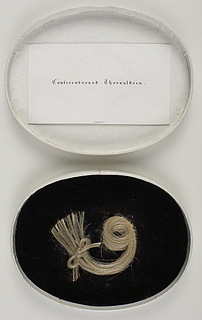 |
It is evident from Wilckens’ text that his compulsion to gather hair by no means stopped with Thorvaldsen. Wilckens’ chamber of wonders also included such fantastic objects as a box of Napoleon’s mother’s hair and a piece of chalk from Raphael’s tomb, both of which are found today in Thorvaldsens Museum; see N86 and N87.
The cult can perhaps be said to remain active in present-day Danish flower shops, where feather grass (Stipa pennata) is still sold today as Thorvaldsens hår [Thorvaldsen’s hair], a name that perhaps has roots in 19th-century hair collecting.
From time to time, the museum receives new locks of hair from generous donors. These are appropriately assigned an inventory number starting with N, which is associated with the group of objects known as Thorvaldseniana. Here each artifact is accompanied by some words deriving either from the Museum’s own inventory protocols or from the short texts accumulated by each lock along its journey to and among the collectors—normally the Copenhagen haute bourgeoisie—in efforts to verify its authenticity.
Both the dispassionate prose of the inventory protocols and the orderly composition of the hairtifacts themselves belie only begrudgingly—but all the more clearly for that (!)—the hair-collecting cult’s complex and grotesque yet glorious mix of idol worship, death, vitality, animism, symbolic power, intimacy, disgust, repressed sexuality, intimacy, surrogate intimacy, museumification, kitsch, hoarding, a fetish for order, snobbery, social climbing, and more.
DNA analysis of the hair clippings is indeed under consideration.
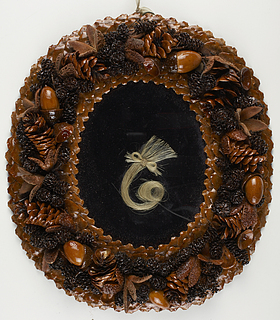 |
N327: Inscribed on the back as follows, presumably by C. F. Wilckens: “A lock of Privy Councillor Berthel Thorvaldsen’s hair. The frame is made out of stems and fruit cobs from the trees in Fredensborg Palace Gardens.” |
It was in a strange manner that I became a collector of Thorvaldsen’s hair. I discovered that his hairbrush and comb had been cleaned, without knowing who had done it; and so I decided to clean them right after dressing him, as my first subsequent task. A few days later, Baroness Stampe approached me and asked: “Who is taking Thorvaldsen’s hair? For several days now I have missed it, and I am collecting it.” Now I knew who had taken the hair from his brush and comb—and it immediately occurred to me that I should have begun doing so myself long ago. So I responded: “I am the one who does it, your Grace! And I hope you will forgive me for continuing to do so; for it certainly must belong to me, as his valet, when he is here in town.” In order to be certain that I was permitted to take it, I asked Thorvaldsen if I might keep the hair that I took from his comb or cut off [while trimming him]. Thorvaldsen smiled and said: “Do you want to collect my hair now? Well then—go ahead, if it interests you! But if you want to be a hair collector, then you should also have a tiny little lock of Napoleon I’s mother’s hairIX.” With those words, Thorvaldsen went to his escritoire. Taking out the box in which the lock lay, he gave me half the lock. “Now this is hair worth saving!” he said. Later that day, he also took out a box containing chalk from Raphael’s graveX. Thorvaldsen had been present at the opening of the grave, from which he, like the others present, had taken a bit of chalk. “Because it seems that you want to be a collector,” he said, “it is best that you also have some of this.” Naturally, I accepted these gifts with gratitude. Many years later, at Thorvaldsen’s final disposition at the MuseumXI, I saw that some pieces of chalk had fallen out of the gravesite. I gathered these up, and at Thorvaldsen’s Centennial FestivitiesXII I gave a piece to each member of the organizing committee.
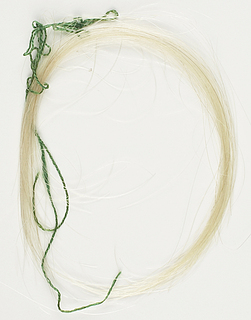 |
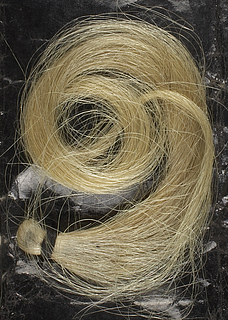 |
| N239: Inscribed on the paper wrapping: “Thorvaldsen’s hair, clipped off after his death.” The lock of hair was presumably owned by Sophie Amalie KurtzhalsXIII, Thorvaldsen’s lover in his youth. | N231: Donated to Thorvaldsens Museum by the UnsgaardXIV siblings, who inherited the lock from their uncle, the nobleman G. S. VogtXV, who had inherited it in turn from his mother Adelgunde VogtXVI, who was a student of Thorvaldsen. |
Mr. Frederik BarfodXVIII intends to gather all public notices, etc., referring to Thorvaldsen, and to publish them as Thorvaldsen’s AlbumXIX. He has issued an invitation to all people to send him contributions, and we do not hesitate to send him the following. Let it be called:
When word of Thorvaldsen’s death reached the public, FædrelandetXX, as is known, wailingly tore its hairXXI. This, however, had no further consequences.
More consequential was the effect of the world-famous artist’s death on Prof. HeibergXXII. Whether it was out of grief for the departed one, or out of despair over finding a rhyme for the declamatory poem that Mrs. Heiberg was to recite in the Royal TheaterXXIII on that occasion, is yet unknown; what is known is that he too tore his hair.
Those who doubted the truth of this became convinced after seeing and hearing how farfetched [haartrukket, lit. “hair-pulled”] the declamatory poem was. What is certain is that, from now on, Prof. Heiberg must wear a wig.
So much for the wig.
Another fact is less well-known. It emerged like a mystery in the night’s silence. But even the night is quiet no more; it has revealed all to Corsaren.
When the great late man lay in stateXXIV, with the laurel wreath on his head, and was to be buriedXXV on the following day, it suddenly occurred to a noble lady that she had no memento of Thorvaldsen—and this she needed to have.
She was not as fortunate as Chief Physician JacobsenXXVI, who had received an uncanny souvenirXXVII at the very moment of Thorvaldsen’s death.
But as stated, she was determined to have a memento; so she sent word and requisitioned a lock of the great artist’s hair.
No sooner had this become known than nearly every noble lady sent word and similarly requested a lock.
Thorvaldsen was a great artist and an upright man; but he was no Samson. Or so the CommitteeXXVIII said to itself, at an extraordinary meeting convened to confer on what was to be done about the matter.
But then an idea arose—a brilliant idea. Here one can see what despair can lead to. The idea was to allow others to give hair to others—naturally, to other artists.
Naturally, the studentsXXIX were not worthy of representing Thorvaldsen with their hair. It was therefore with a certain pride that the professorsXXX offered their hair, their heads’ glory, for the cause.
Some of this hair was black, some grey, some red; while Thorvaldsen had had white hair.
The ladies wondered at this, and one, who had received a large red curl, said: “I have surely been swindled; the servant went up to a barber.”
But the Committee, to whom she sent an inquiry, replied that she had not been fooled. She should consider that people change in death.
That fact is unprovable.
But enough: this is why we have such bald professors at the Academy.
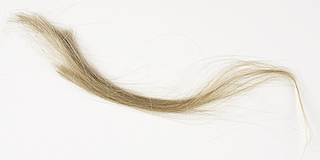
N230: Inscribed on the paper wrapping:
“Thorvaldsen’s hair – Mother received it from Uncle Caspar KongslevXXXI,
who was an instructor at the Academy of Fine Arts”
Last updated 27.09.2023
This text was published previously, in a somewhat different form, in the journal ARK 73, 2006/2007:4.
See also the biography of C. F. Wilckens.
The Danish baroness Christine Stampe.
The Danish official Jonas Collin.
Cf. Johanne Luise Heiberg, Et Liv, gjenoplevet i Erindringen [A Life, Reexperienced in Memory], Copenhagen 1944, vol. IV, p. 347: “It was part of the enthusiasm for Thorvaldsen to gather his beautiful white hair; the valet Wilckens and Baroness Stampe were especially eager. There are still many locks left. Jonas Collin cut many, when Thorvaldsen’s body was brought to Charlottenborg, and he was presumably the one who gave Mrs. Heiberg a lock for memory’s sake.”
Prince Valdemar (1858-1939) was the youngest son of King Christian IX.
Princess Thyra, Duchess of Cumberland (1853-1933) was the youngest daughter of Christian IX; the above-mentioned Prince Valdemar was her younger brother.
An excerpt from Carl Frederik Wilckens’: Træk af Thorvaldsens Konstner- og Omgangsliv samlede til Familielæsning [Aspects of Thorvaldsen’s Artistic and Daily Life, Collected for Family Reading], Copenhagen 1874, pp. 18-19 (republished as Thorvaldsens sidste år. Optegnelser af hans kammertjener [Thorvaldsen’s Last Years: Reports by His Valet], Copenhagen 1973, p. 80-81). Wilckens was Thorvaldsen’s valet.
Namely, a lock of the hair of Letizia Bonaparte, who incidentally lived and died in Rome. As mentioned above, this specimen is found today at Thorvaldsens Museum, N86. The lock is chestnut brown flecked with grey, and is preserved in a cylindrical box of black horn.
Namely, chalk from the tomb of the Renaissance painter Raphael (1483-1520) at the Pantheon in Rome, N87. The grave was opened on 14.9.1833 in the presence of Thorvaldsen among others, as Wilckens reports in the citation below. The opening of the grave is depicted in a painting by Francesco Diofebi, B73, and the skeleton itself can be seen on a lithograph, E1100.
Thorvaldsen’s corpse was laid to rest in the tomb in the Museum’s courtyard on 6.9.1848, a good four years after his death on 24.3.1844.
The centennial of Thorvaldsen’s birth was celebrated on 19.11.1870, with major festivities in Copenhagen and Stockholm, among other places.
For more on Sophie Amalie Kurtzhals, see her biographical page.
Probably the Danish minister I.J. Unsgaard and an unidentified brother or sister.
Unsgaard was married to Vilhelmine Alvilda Herbst (1816-1851), a sister Adelgunde Vogt, née Herbst, mentioned below.
However, the Unsgaard siblings could also be descendants of I.J. Unsgaard.
The Danish sculptor and landowner Gundo Vogt (1852-1939); see also Weilbachs Kunstnerleksikon.
The Danish sculptor Adelgunde Vogt.
The text was printed in Meïr Goldschmidt (ed.), Corsaren, no. 187 (April 12, 1844), pp. 8-9, that is, three weeks after Thorvaldsen’s death on 24.3.1844.
The illustrations also derive from Corsaren.
The Danish author and politician Frederik Barfod.
Barfod’s anthology of short texts, poems, and memoirs of Thorvaldsen was published after the sculptor’s death under the title Thorvaldsensk Album [Thorvaldsenian Album], Copenhagen 1844.
All texts have been re-published in this archive.
Lit. “the fatherland”; also the name of a local newspaper that served as the mouthpiece for the national liberals, and played a crucial role in shaping public opinion during the tumultuous period in Danish history around the middle of the nineteenth century.
This reference in Corsaren may refer, for example to the fact that on 25.3.1844, the day after Thorvaldsen’s death, the newspaper Fædrelandet appeared with a black mourning border around the entire front page, and the headline: “Thorvaldsen is dead! The high priest of beauty is no more!” This line is repeated in boldface twice more on the front page, as the refrain in an elegy. In the end it is replaced with this variant: “Thorvaldsen is dead! But he lives on in his works and in his people!”
See also the related article Worshipping Thorvaldsen.
The Danish author J. L. Heiberg.
The Royal Danish Theatre held a memorial service for Thorvaldsen on 9.4.1844. Here Johanne Luise Heiberg recited her husband’s Prologue, J.L. Heiberg: Thorvaldsen. Prolog ved det kongelige Theaters Sørgefest, den 9de April 1844 [Thorvaldsen: Prologue at the Royal Theater’s Memorial Service], Copenhagen 1844.
Corsaren’s ironic reference to the rhymes in Heiberg’s “declamatory poem” probably refers to the fact that it had no rhymes at all: it was written in unrhymed hexameters.
Johanne Luise Heiberg described her own performance as follows: “I did not recite the beautiful prologue as I had wished. I was too numb and still too close to my grief to be able to express with artistic tranquillity the grief felt so deeply by all.” See Johanne Luise Heiberg, Et Liv, gjenoplevet i Erindringen [A Life, Reexperienced in Memory], Copenhagen 1944, vol. II, p. 33.
Thorvaldsen’s body lay in state in the ceremonial hall of the Academy of Fine Arts on 29.3.1844.
Thorvaldsen’s funeral was held at the Church of Our Lady in Copenhagen 30.3.1844.
The Danish doctor Johan Peter Jacobsen.
On March 25, 1844, the day after Thorvaldsen’s death, Jacobsen was accused in the newspaper Fædrelandet of having precipitated the sculptor’s death by improper medical treatment. This accusation, however, was groundless; for more on this, see the Related Article On the Cause of Thorvaldsen’s Death.
Corsaren must be referring to the Committee for the Establishment of Thorvaldsens Museum.
I.e., the students at the Academy of Fine Arts.
I.e., the professors at the Academy of Fine Arts.
The Danish painter Caspar Peter Kongslev, who taught at the Academy of Fine Arts.